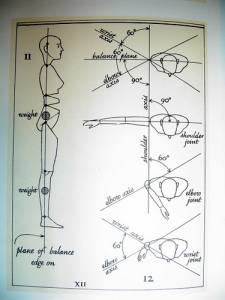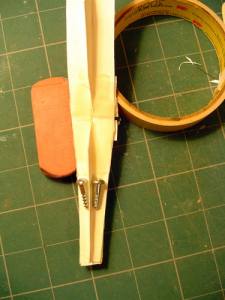|
 The legs start the same was as the arms did, so we’ll skip all that and go straight to the knee joint. I glue two pieces of fabric to the back of the leg, making sure that the joint is completely snug. It is important to have things tight, so that I don’t have slop in the movement. The legs start the same was as the arms did, so we’ll skip all that and go straight to the knee joint. I glue two pieces of fabric to the back of the leg, making sure that the joint is completely snug. It is important to have things tight, so that I don’t have slop in the movement.
|
|
 With both sides, I need the glue to go right up the edge, without dropping into the space between the upper and lower leg. With both sides, I need the glue to go right up the edge, without dropping into the space between the upper and lower leg.
|
|
 When I glue the cloth to the front of the knee, I bend it. If I glued the cloth on with the knee straight, it would act as a stop and prevent the knee from bending. When I glue the cloth to the front of the knee, I bend it. If I glued the cloth on with the knee straight, it would act as a stop and prevent the knee from bending.
|
|
 You’ll note that when the leg is assembled there is a tiny gap between the front part of the upper and lower legs. This gives me room to install the stop (which will be two pieces of paper) without the thickness of the stop becoming a wedge that would keep the leg from straightening all the way. You’ll note that when the leg is assembled there is a tiny gap between the front part of the upper and lower legs. This gives me room to install the stop (which will be two pieces of paper) without the thickness of the stop becoming a wedge that would keep the leg from straightening all the way.
|
|
 You can see how the stop fills that gap neatly in? We’ve got a smooth line from hip to ankle. You can see how the stop fills that gap neatly in? We’ve got a smooth line from hip to ankle.
|
|
 And this is what the stop looks like when the leg is bent. It’s sort of like a freaky puppet in its own right. And this is what the stop looks like when the leg is bent. It’s sort of like a freaky puppet in its own right.
|
|
 Now here’s where things get cool. This is a plate from the book, The Dwiggins Marionettes, which is the classic text on building marionettes. (It also happens to be gorgeous in part because William Addison Dwiggins was a font designer, in fact, the font I’ve been using in the Building Coraline videos is one of his.) One of the things he talks about is the balance of the figure. You’ll note in this plate that he puts a weight in the calf to help with natural movement. Now here’s where things get cool. This is a plate from the book, The Dwiggins Marionettes, which is the classic text on building marionettes. (It also happens to be gorgeous in part because William Addison Dwiggins was a font designer, in fact, the font I’ve been using in the Building Coraline videos is one of his.) One of the things he talks about is the balance of the figure. You’ll note in this plate that he puts a weight in the calf to help with natural movement.
|
|
 I’ll grant that two screws are not as elegant as lead, but they serve the same purpose. This is part of why I say that Coraline will be made almost entirely out of paper. Honestly, I usually use washers or for this, but she is so small that I didn’t have any that would fit and provide the weight I needed. I’ll grant that two screws are not as elegant as lead, but they serve the same purpose. This is part of why I say that Coraline will be made almost entirely out of paper. Honestly, I usually use washers or for this, but she is so small that I didn’t have any that would fit and provide the weight I needed.
|
Any questions?
Mary,
I was just looking through the Coraline series and now the part where you weight the calves…had a thought about lead fishing weights. I use them to weight my marionettes. they come round or egg shaped. I whack them flat with a hammer and then divide them with a cold chisel. The nice thing is that they are very flat, heavy and can be as small as you like.
Just want to say thank you for your site…
now i want a bandsaw!
un abrazo
Deborah
Hi Deborah,
Thanks for reminding me about fishing weights. I’ve used those on wood puppets, but I think I switched to the washers because the paper was so darn light that it was easy to add too much weight with sinkers. Honestly though, it’s been such a long time since, that I might have also made the switch because washers were easier to find. I should experiment again.